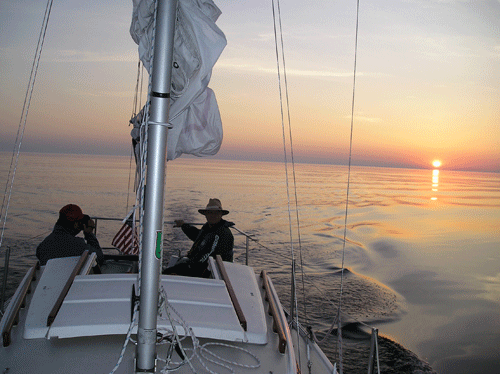Lake Dubay Sailing Association
Come sail with us!
A Lake Michigan Crossing
By Mike Koss
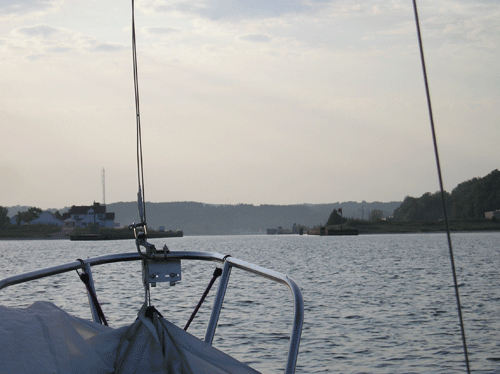
Sometime in the winter of 2006, I seriously got the bug to sail across a great lake, and asked my cousin Chuck Jagodinski if he was game, to which he replied in the affirmative.
So it eventually came to pass that on the morning of June 14th 2007, Mel Smith, Chuck and I piled our gear into my SUV, hooked up to BlewBoat, and headed for Algoma, WI on the shore of Lake Michigan.
The plan was to get a decent weather window, dash across to Frankfort, Michigan, recoup, and dash back before the weather had a chance to turn sour. After watching the weather intently for the week before departure, we decided to go, as regional weather was fairly settled.
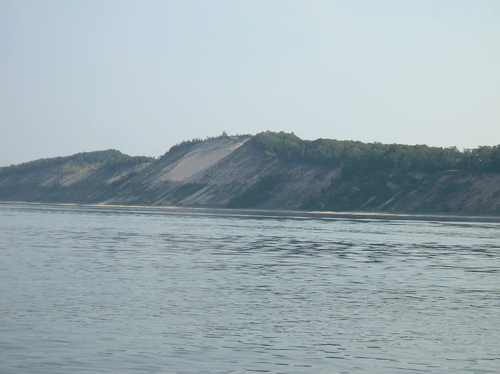
We arrived at Algoma Municipal Marina at about noon. We set up BlewBoat, stowed our gear, parked the truck and trailer, and headed out of the friendly little harbor a little after 2:00 pm, onto a warm sunlit sea. Unfortunately, the high pressure cell that had been sitting over the Mackinac Strait for several days was not moving and was keeping winds to a minimum- about 4 to 5 knots. We set the tillerpilot on an 88 degree course for Frankfort, raised the sails for effect, and settled in for the long trip across the pond. We did two long tacks across the rhumbline to try coax a little more energy out of the weak breeze, but came to the conclusion that it wasn’t worth the extra fuel and time it would cost to continue- what little breeze there was, was out of about 100 degrees- close enough to being on the nose We eventually dropped all sail and ran under power alone, coordinating handheld GPS and Tillerpilot. As night fell, out of sight of land, the warm day turned rapidly cooler, to the point that all three of us had on most of the heavier clothing we had- it does get quite cool on the Lake at night, from the lower fifties to upper forties.
Once darkness set in, with a new moon, the world was as dark as the inside of a cow, except for the stars, which shone more brilliantly than most of us ever see- the stars were really something.
We encountered a fair number of ships, all from a safe distance of several miles. There are five main north-south shipping routes on the lake, and we saw ship traffic in three of them.
Sometime after 10:00 pm, I caught a little sleep on the starboard settee while Chuck and Mel stood watch. When I woke up at about midnight, we were about 9 miles out from Frankfort, heading directly for our destination waypoint- the harbor entrance lighthouse.
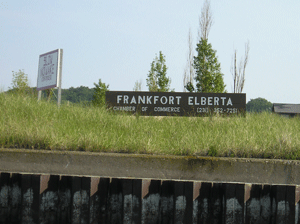
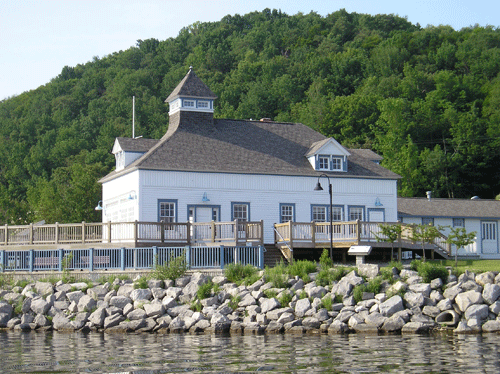
At this point we also discovered that two of the busiest shipping lanes on the lakes run through this area 5 to 10 miles off Betsie Point. Two ships here had all there deck lights turned on and looked like floating cities, northbound.
I was reluctant to chance entering a strange harbor at night, so at a little after 2:00 am (3:00 am Eastern time) we approached with 1.5 miles of the harbor entrance, shut off the motor, turned on the anchor light, lashed the tiller to port, and finally went to sleep.
We awoke at 6:00 AM to the sound of the sportfishing fleet heading out of the harbor entrance for early-morning trolling. After getting ourselves organized, we motored the final distance into the harbor, and tied up to the Frankfort Municipal Marina fuel Dock.
After topping off the one empty tank, we tied off as directed to an open slip, which The City of Frankfort rents for $5.00 per hour. Most of the slips in the municipal marina were not occupied- imagine that. Being told that there was not a restaurant open for breakfast within walking distance, we settled for coffee and a donut at the gas station across the road. There was however a nice little waterfront park.
At about 8:15 we cast off, took a quick tour of the harbor, and headed back out onto the Lake, heading 269 degrees for Algoma, again with almost no wind. We finally found 5 knot breezes several miles out, and again picked up approximately a bonus knot to move us along at around 5 knots. Another sunny warm day developed, and with the tillerpilot again doing the steering chores, we settled in for the long trip to Algoma. In mid lake, we killed the motor for a time, but were only able to maintain 2.5 knots or so- not nearly enough speed for the distance we had left to go, so motorsail on we did. We picked up the Wisconsin shore about 15 miles out, and began passing through the sportfishing fleet at 5 miles out. We reached the harbor at a little after 7:00 pm Friday, June 15. After loading up BlewBoat and readying for travel, we had a great pizza dinner in Algoma, and headed for home.
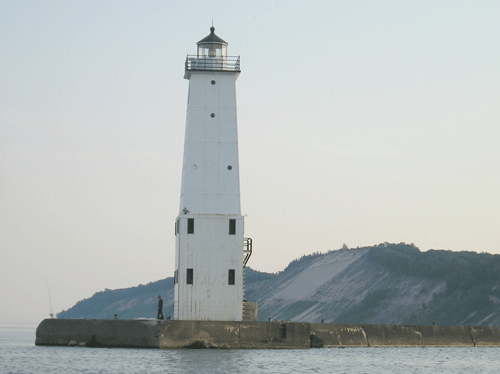
Postscript:
By way of preparation for this passage, I had read as much as I could get my hands on regarding offshore sailing, heavy weather boat handling, idiosyncrasies of the Catalina 22, and general topics of seaworthy offshore sailboat design. Particularly inspiring was the book “Tinkerbelle” by Robert Manry, in which he describes in detail the modifications he made to a 12 foot Old Town sailboat to make it seaworthy enough to cross the Atlantic Ocean in 1965. Also very helpful was the book “The Seaworthy Offshore Sailboat” by John Vigor.
Lessons learned through this research:
Seaworthiness is not related to size of boat, but to design and preparedness.
Size of boat is related to creature comforts, not to seaworthiness.
Specifically, additions made to BlueBoat for this project included:
Addition of a Radar Reflector
- Addition of a high-capacity bilge pump
- Addition of long-range fuel tankage- two 6.6 gal tanks to replace the single 2.5 gallon tank that came with BlewBoat. New range approx. 90 miles.
- Addition of approximately 2300 lbs of flotation (stryrofoam) to provide positive buoyancy in event of swamping, since we did not plan to carry a liferaft.
- Rental of a 406 MHz EPIRB through Boat US.
- Removal of the galley unit to provide more interior space for three men.
- Addition of dedicated jackline cleats and jacklines, along with harness PFD’s and tethers
- Addition of a reefing hook at the gooseneck, (and practiced jiffy reefing in high winds the week before the trip.)
Would we do this trip again? Absolutely, but would wait for the right winds if possible. I would pick a different destination- somewhere a little more cruiser-friendly.
The sensation of sheer space, out of sight of land, is something one has to experience- it’s too hard to describe. Also, the sensation of “magnificent desolation” being mid-lake in pitch-black dark is also hard to describe- it’s something you have to feel. We had anticipated much rougher seas, and so took precautions against seasickness by dosing with Dramamine starting 24 hours ahead of departure.
After following weather on Lake Michigan for a few weeks, it seems that 7-15 kt winds blowing for a 24 hour period will build seas of about 3 feet, well within the comfort level for a Catalina 22. 15 to 20 knot breezes for a day will build seas to about 5 feet- still OK for a Catalina 22. 25 knot breezes blowing for a day will produce 8 foot seas, which would probably not be a lot a fun if you have any miles to put behind you. When looking at wave forecasts, it’s important to remember that the wave heights listed are dominant wave heights, which is the average of the largest third of the waves. Linear wave theory then predicts that about 1 wave in 25 will be twice the dominant wave height, and one wave in about 1200 will be a “rogue wave”, about 3 times the dominant wave height. So you have to be careful what you wish for. Enough wind to make for exhilarating sailing, but not so much wind as to raise dangerous seas. For the Catalina 22, 15 knots would be perfect: 25 knots would make for spectacular sailing until the seas had a chance to build to Dramamine levels.
Mike Koss
BlewBoat
